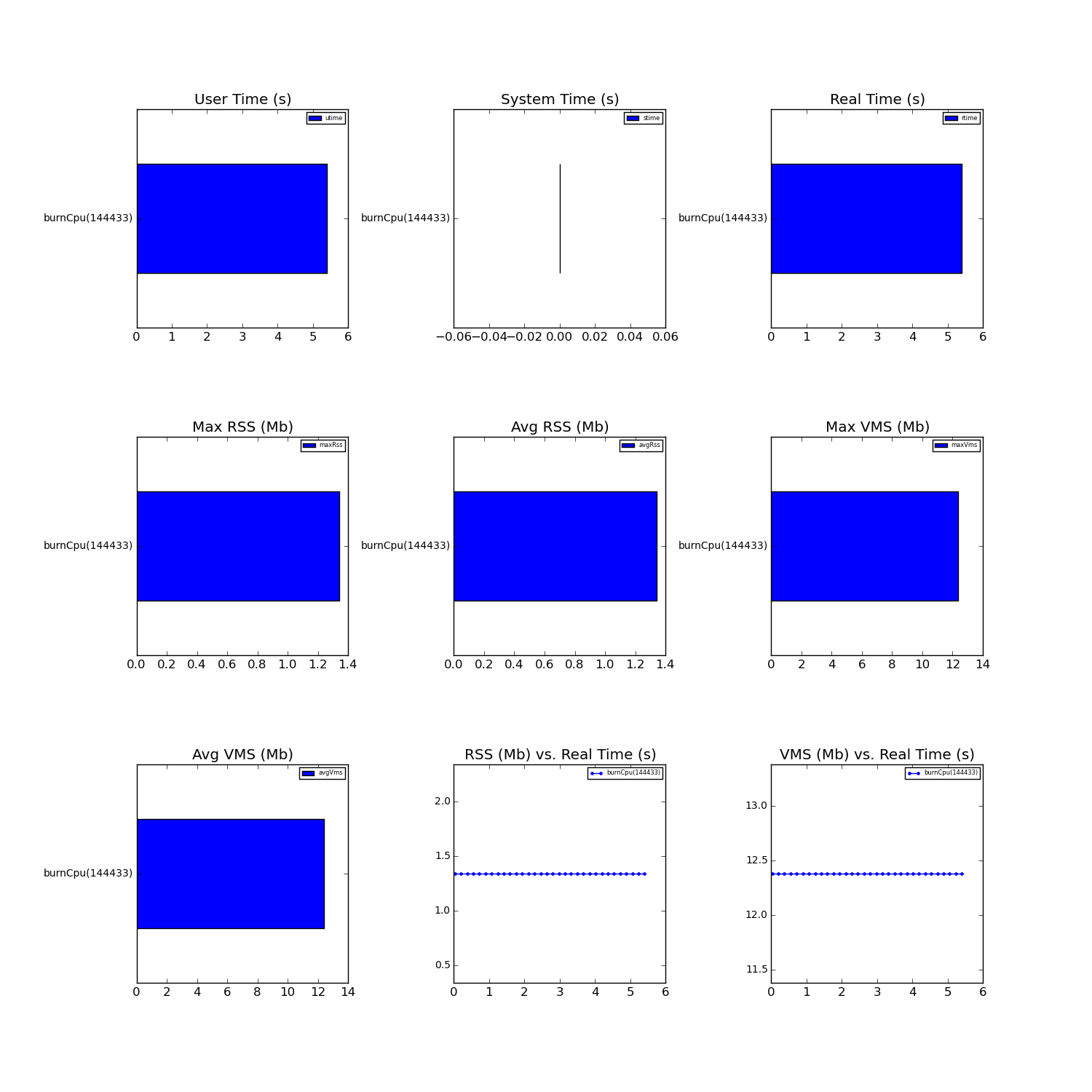Benchmark resources usage
Project description
Monitor Process Resources Usage
Examples
We showed several examples below. Please note that all output are tabularized for demonstration purpose.
Example 1: simple command.
$> monitor.py sleep 2 pid ppid utime stime rtime rss vms maxRss maxVms avgRss avgVms cwd cmd 133692 133675 0.0 0.0 1.9368159771 774144 6066176 774144 6066176 774144.0 6066176.0 /home/zhanxw/mycode/bench/scripts sleep 2
Example 2: complex shell commands with sampling interval equaling to 0.1 second
This example will use shell to start 3 processes: sleep 2, sleep 4 and seq 1000000. You can see bench can monitor all 4 processes all together.
$> monitor.py sh -c 'sleep 2 & sleep 4 & seq 1000000 >/dev/null & wait' pid ppid utime stime rtime rss vms maxRss maxVms avgRss avgVms cwd cmd 135004 134985 0.0 0.0 3.9532430172 798720 4558848 798720 4558848 798720.0 4558848.0 /home/zhanxw/mycode/bench/scripts sh -c sleep 2 & sleep 4 & seq 10000000 >/dev/null & wait 135006 135004 0.0 0.0 3.95348381996 655360 6066176 655360 6066176 655360.0 6066176.0 /home/zhanxw/mycode/bench/scripts sleep 4 135005 135004 0.0 0.0 1.83160495758 774144 6066176 774144 6066176 774144.0 6066176.0 /home/zhanxw/mycode/bench/scripts sleep 2 135007 135004 0.05 0.0 0.0599648952484 720896 6090752 720896 6090752 720896.0 6090752.0 /home/zhanxw/mycode/bench/scripts seq 10000000
Example 3: generate performance metrics to external file
Here we used a small program, burnCpu. It will keep CPU running for several seconds. Its source code is under src/.
The option -t will enable outputting traces. That means at several time stops, performance metrics of each processes will be outputted to the standard error as well as a separate comma-separated file, $prefix.trace.csv.
The option -g will generate a graph which contains several sub-figures, including timings for each processes, memory consumption for each processes, and memory consumption over the processing running time.
The option -o will specify the output prefix. The default value will be bench, meaning, you will get bench.csv. You can overwrite this value by using -o option.
$> monitor.py -t -g -o burnCpu ./burnCpu pid ppid utime stime rtime rss vms cwd cmd 135471 135454 0.04 0.0 0.0441780090332 1449984 12984320 /home/zhanxw/mycode/bench/scripts ../src/burnCpu 135471 135454 0.2 0.0 0.205282926559 1449984 12984320 /home/zhanxw/mycode/bench/scripts ../src/burnCpu 135471 135454 0.38 0.0 0.381079912186 1449984 12984320 /home/zhanxw/mycode/bench/scripts ../src/burnCpu ...
Additional result are stored in burnCpu.csv, burnCpu.trace.csv in the Comma-separated format (CSV).
burnCpu.csv file content
pid,ppid,utime,stime,rtime,rss,vms,maxRss,maxVms,avgRss,avgVms,cwd,cmd 144433,144416,5.4,0.0,5.40555810928,1404928,12984320,1404928,12984320,1404928.0,12984320.0,/home/zhanxw/mycode/bench/scripts,../src/burnCpu
burnCpu.trace.csv file content
pid,ppid,utime,stime,rtime,rss,vms,cwd,cmd 144433,144416,0.03,0.0,0.0423669815063,1404928,12984320,/home/zhanxw/mycode/bench/scripts,../src/burnCpu 144433,144416,0.19,0.0,0.20046210289,1404928,12984320,/home/zhanxw/mycode/bench/scripts,../src/burnCpu 144433,144416,0.36,0.0,0.373480081558,1404928,12984320,/home/zhanxw/mycode/bench/scripts,../src/burnCpu ...
When -g optioned is specified, bench will generate several performance metrics in the file burnCpu.trace.csv:











